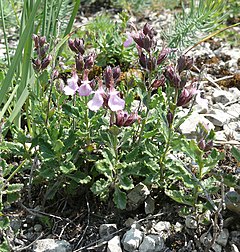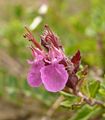Teucrium chamaedrys
| Teucrium chamaedrys subsp. var. | Ground oak, Wall germander | |||||||||||||||||||||||||||||||||||||||||||||||||||||||
|---|---|---|---|---|---|---|---|---|---|---|---|---|---|---|---|---|---|---|---|---|---|---|---|---|---|---|---|---|---|---|---|---|---|---|---|---|---|---|---|---|---|---|---|---|---|---|---|---|---|---|---|---|---|---|---|---|

|
|
| ||||||||||||||||||||||||||||||||||||||||||||||||||||||
| ||||||||||||||||||||||||||||||||||||||||||||||||||||||||
Wall germander (Teucrium chamaedrys) is a species of ornamental plant native to Europe and the Near East. It was historically used as a medicinal herb for the treatment of gout and sometimes as a component of Venice treacle.
Wall germander is a creeping evergreen perennial 6 to 18 inches in height. Its scalloped, opposite leaves are 1/2 - 1 1/2 inches long, dark green, and shiny. In late summer, tubular flowers grow in whorls from the leaf axils.
| Standard Cyclopedia of Horticulture |
|---|
|
Teucrium chamaedrys, Linn. Perennial or shrubby, 1-2 ft. high, base decumbent, branching, pubescent or villous: lvs. short-petioled, ovate or oblong, incised-crenate, base cuneate, both surfaces green or canescent beneath; floral lvs. smaller and dentate: floral whorls 2-6-fld., the upper racemose: fls. red-purple or bright rose, with red and white spots, 3/4 in. long, rather showy; calyx tubular-campanulate, teeth lanceolate, acuminate. Eu.—A good border plant for late summer bloom. CH
|
Cultivation
- Do you have cultivation info on this plant? Edit this section!
Propagation
It may be propagated by vegetative cuttings or by the division of established clumps.
Pests and diseases
- Do you have pest and disease info on this plant? Edit this section!
Species
Gallery
If you have a photo of this plant, please upload it! Plus, there may be other photos available for you to add.
References
- Standard Cyclopedia of Horticulture, by L. H. Bailey, MacMillan Co., 1963
External links
- w:Teucrium chamaedrys. Some of the material on this page may be from Wikipedia, under the Creative Commons license.
- Teucrium chamaedrys QR Code (Size 50, 100, 200, 500)

